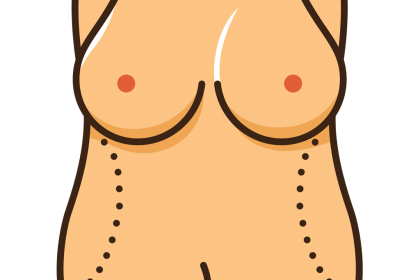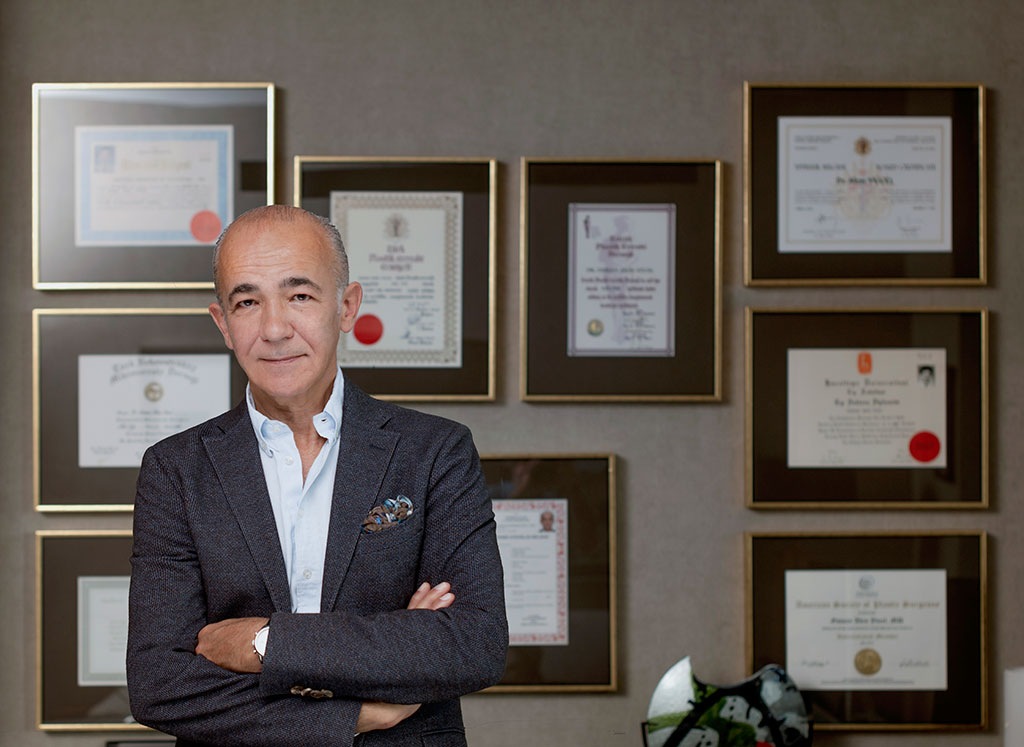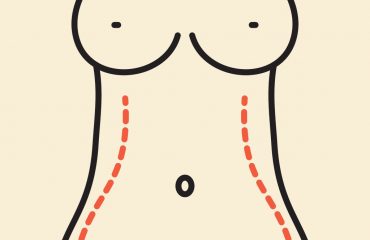
Our fat tissue is made up of fat cells whose number does not change after we are out of puberty. What changes is their size. Fat cells are the energy depots of the body. When we eat too much, they become bigger, when we fast, they shrink. Fat cells also secrete a number of hormones. Two types of fat tissue are distinguished: subcutaneous fatty tissue which can be controlled in its size through physical activities and diet, and visceral fat which lies deeper in the body and fills the cavities between organs in the abdomen. Visceral or abdominal fat is genetically programmed and difficult to influence through eating habits and sports. Women store their fat in the hips, buttocks and thighs, in the pelvic region and the belly, while in men it is concentrated in the belly and around the waist. Visceral fat is known to be associated with heart problems.
Once we are past 30, is becomes ever more difficult to reduce our excess fat with a nutritional regime and physical exercise; or we lose fat where we don’t want to. In women the fatty tissue in the face and breasts may decrease while the fat reserves on the hips remain intact. In these cases liposhaping is an effective solution.
During the procedure, fat is removed through liposuction where it is in excess and after purification re-injected where there is too little. The goal of the process is not weight decrease but redistribution of the fat tissue.
Frequently asked questions about liposhaping:
How is the procedure performed?
Liposhaping is a three-step process of liposuction, fat purification and fat injection. At first, the fat transfer areas (removal and re-injection) are determined. Liposuction is performed in a clinic under local anaesthesia. The patient is also given medication that prevents bleeding. The fat tissue is sucked out with under a low vacuum with the aid of cannula, collected in a sterile vessel, purified, concentrated and re-injected with very fine needles in the predetermined areas of the body.
Who is a good candidate for liposhaping?
The success of the treatment depends on the ability of the skin to tighten itself after fat removal and the associated volume loss. In other words it depends on the skin’s elasticity. Someone who has gone through several cycles of strong weight gain and loss is no good candidate. Multiple childbirths also take their toll on the skin elasticity in the abdominal region. Liposuction is no slimming procedure. It rather serves the purpose of removing fat deposits that do not react to a diet regime or physical activities. The best preconditions are: not too high age, good skin elasticity and only little overweight.
What is a good age for liposhaping?
Any age as long as the skin is still elastic enough. This is usually true up to a middle age, in individual cases even an advanced age is no hindrance.
In which areas of the body is the fat harvested?
The formation of fat tissue deposits is genetically determined. In women the main areas are hip, belly, thigh and neck; in men it is belly, waist, chest and neck. A typical deposit in men is the visceral abdominal fat.
The removed fat is injected where necessary. The most important areas of application are leg shaping and tightening, and breast augmentation.
What is „high-definition’ liposhaping?
It is a body contouring method (e.g. “six pack” in men, the pubic area, abdomen, waist and back in women) which is most suitable for younger and sportive people with good skin elasticity and only little or no overweight.
How is the fat removed?
The fat is sucked out of its deposits by applying a vacuum to a suction cannula. To improve the effectiveness of the process, ultrasound or laser light may be applied to loosen up the fat tissue.
What is ultrasound liposuction?
In this procedure, the fat tissue is loosened up with ultrasound to improve the suction efficiency. The ultrasound is applied through small tubes inserted through small incisions in the skin. A recently developed new technique, the so-called vaser system, is highly efficient.
What are the advantages of the vaser system?
It facilitates the dissolution of fatty tissue and thus greatly improves the suction process. That is a great advantage for fat deposits in the back and in male breasts (gynaecomastia). It also stimulates the skin to tighten. There is no definite proof, however, that, in the long term, vaser treatment yields better results than the classical liposuction practice. Disadvantages are longer operation times and a slight risk of burns.
What is laser lipolysis?
It is a method of dissolving fatty tissue with the aid of laser beams which are applied through small cuts in the skin. Laser lipolysis improves the efficiency of liposuction. In the case of small fat deposits, laser lipolysis alone is sufficient to remove the fat, as the dissolved fatty tissue is readily absorbed by the body. The greatest advantage of this technique is rapid skin tightening. The method is particularly suitable for small fat deposits in the neck and thigh. However, it is not justified to speak of a superior method with respect to classical liposuction. And there is always a slight risk of burns.
How do radio waves affect liposuction?
Besides laser light and ultra sound, radio waves can also be applied under the skin. They also have a skin tightening effect.
What to do and what not to do before treatment?
Three weeks before an invasive / surgical treatment patient must stop smoking and taking aspirin. In the last week, patients must stop taking any anticoagulant (“blood-thinning”) medicine.
The following substances are also prohibited:
• pain killers such as Apranax, Voltaren and Vermidon (alternative brand names are Minoset and Novalgin)
• multivitamin tablets containing ginseng, ginkgo biloba and coenzyme Q,
• green tea, herbal products containing linseed, sour cherry stalks, tomato seeds
• all diet products.
Do I have to lose weight before liposhaping?
Liposhaping is not suitable for very overweight people. The ideal candidate is about regular weight with small fat deposits. Patients may be requested to lose weight before the treatment. If the weight loss is not permanent or stable, sustainability of the result cannot be guaranteed. I ask my patients to attain their long-term weight optimum before I begin the treatment.
Does the procedure require anaesthesia?
That depends on the area of intervention. For a limited procedure, a local anaesthetic and sedation are sufficient. For more extensive interventions, general anaesthesia is necessary.
How long does the procedure take?
That depends on the individual scope of intervention. A simple neck liposuction takes 30 minutes, a more comprehensive application to the abdomen, back and thighs can take 5-6 hours.
Is liposhaping painful?
That depends on the area of intervention. The back and the waist are particularly sensitive to pain. However, patients talk about a deep rather than acute pain. It is comparable to an intensive muscle ache after physical activity. The pain may last a couple of days.
Do I have to wear a corset after liposhaping?
All areas of intervention are supported by a corset which must be worn for about 3 weeks. In the first week, you have to wear it permanently, in the following weeks you can take if off for a couple of hours every day.
What happens after the liposhaping procedure?
Three hours after the procedure, patients can eat and get up. After 6 hours they are usually discharged. Incisions are covered with a gauze bandage for the next 24 hours because fluids may seep out. After 2 days patients can take a bath. After 3 days patients return for a follow-up check, after which they can return to their normal activities. In the first 3 weeks, patients should refrain from any sports activities except walking. After 2 weeks, skin-tightening treatments are recommended (lymph drainage massage, radio waves, LPG). After 3 weeks they can take off the corset for good. Until then all swelling and bruising have disappeared. Full skin tightening is completed only after 3 months. The skin may be temporarily numb at the cannula insertion points.
What should I do after liposhaping to support the healing process?
To quickly dissolve the oedema, lots of movement and intake of much liquid is recommended. A strong moisturising lotion should be applied to the areas of intervention. After 2 weeks, skin-tightening treatments are recommended (lymph drainage massage, radio waves, LPG). Patients should check their weight daily and try to reduce it.
What problems can occur after liposhaping?
If carried out by an expert and within reasonable limits, liposhaping is a very safe technique. The most serious complications are bleedings, pulmonary emboli, fat emboli and organ injuries. Fat embolism is very rare, however. Injuries to organs, on the other hand, are the most important cause of death associated with liposuction. This can happen in particular when the intestines or the liver are injured during interventions in the abdomen.
The most important problems, however, are aesthetic in nature. They include: loose skin, colour changes in the skin, shape changes. The most important cause for this are wrong application, fat removal beyond a reasonable limit and insufficient skin elasticity. Such mistakes can be corrected, but it is no easy task because it requires further fat tissue transfer between different areas of the body.
Will new fat deposits be formed after liposuction?
Since the fat cells in adults no longer divide, the result is permanent. Weight gain is still possible, however, not to the extent before the treatment.
Will fat deposits emerge in other places after liposuction?
If the patient again gains weight, the fat deposits will form in other places. If, e.g. the fatty tissue has been removed in the abdomen, new fat surpluses will be stored in the back, the arms and legs. Patients must be advised before the treatment that they need to maintain their weight permanently. This does not apply to small interventions, only to comprehensive liposhaping. The worst candidates for this procedure are people with extreme weight imbalances.
How much fat can safely be removed from the body?
Liposuction is no slimming method. On average 2-4 litres of fatty tissue are removed, on rare occasions a little over 5 litres. If over 10% of a person’s live weight is removed, we enter the danger area; for a person weighing 70 kg for example, the limit is 7 litres.


